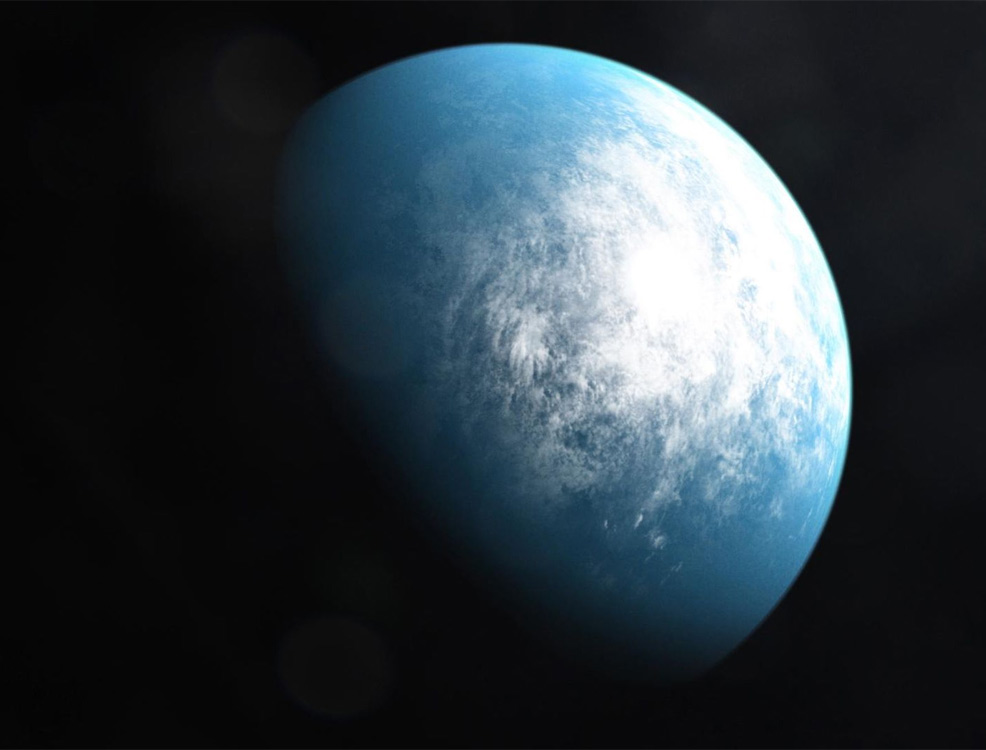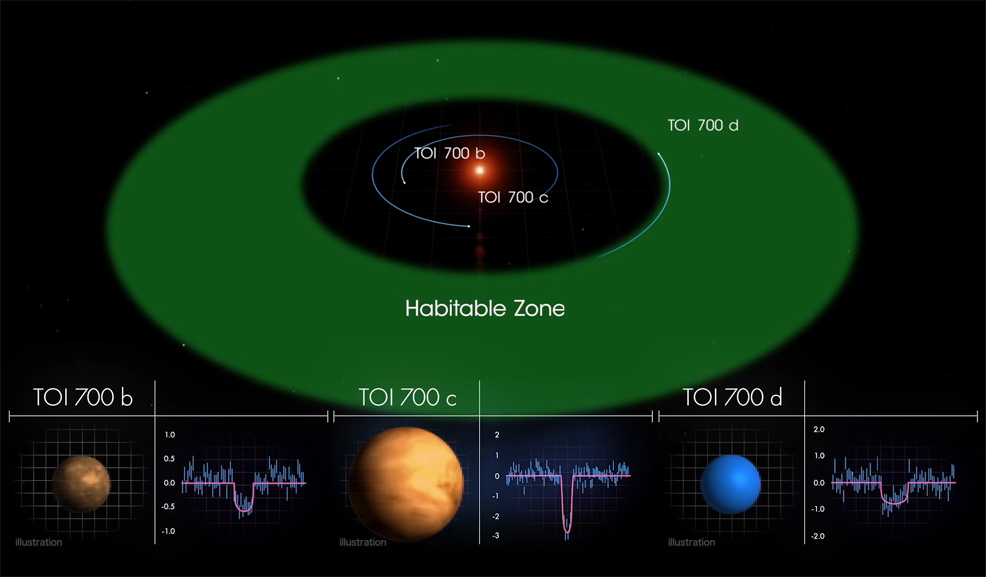
7th January 2020 Earth-sized exoplanet found in habitable zone NASA reports the discovery of TOI 700 d, the first Earth-sized exoplanet in the habitable zone discovered by the Transiting Exoplanet Survey Satellite (TESS). The exoplanet orbits the star TOI 700, about 100 light-years away in the Dorado constellation.
NASA's Transiting Exoplanet Survey Satellite (TESS) has discovered its first Earth-size planet in a star's habitable zone, the range of distances where conditions may be just right to allow the presence of liquid water on the surface. Scientists confirmed the find – called TOI 700 d – using NASA's Spitzer Space Telescope and have modelled the planet's potential environments to help inform future observations. TOI 700 d is one of only a few Earth-sized planets discovered in a star's habitable zone so far. Others include several planets in the TRAPPIST-1 system and other worlds discovered by NASA's Kepler Space Telescope. TESS monitors large swathes of the sky, called "sectors", for 27 days at a time. This long stare allows the satellite to track changes in stellar brightness caused by an orbiting planet crossing in front of its star from our perspective, an event called a transit. "TESS was designed and launched specifically to find Earth-sized planets orbiting nearby stars," said Paul Hertz, astrophysics division director at NASA Headquarters in Washington. "Planets around nearby stars are easiest to follow-up with larger telescopes in space and on Earth. Discovering TOI 700 d is a key science finding for TESS. Confirming the planet's size and habitable zone status with Spitzer is another win for Spitzer as it approaches the end of science operations this January."
The TOI 700 star, located 101 light years away in the southern constellation Dorado, is a small and cool M-class dwarf about 40% of the Sun's mass and size and with half its surface temperature. The star appears in 11 of the 13 sectors TESS observed during the mission's first year, and scientists caught multiple transits by its three planets. The innermost planet, called TOI 700 b, is almost exactly Earth-size, is probably rocky and completes an orbit every 10 days. The middle planet, TOI 700 c, is 2.6 times larger than Earth – between the sizes of Earth and Neptune – orbits every 16 days and is likely a gas-dominated world. TOI 700 d, the outermost known planet in the system and the only one in the habitable zone, measures 19% larger than Earth, orbits every 37 days and receives from its star 86% of the energy that the Sun provides to Earth. All of the planets are thought to be tidally locked to their star, which means they rotate once per orbit, so that one side is constantly bathed in daylight. "Given the impact of this discovery – that it is TESS's first habitable-zone Earth-size planet – we really wanted our understanding of this system to be as concrete as possible," said Joseph Rodriguez, at the Harvard–Smithsonian Center for Astrophysics in Cambridge, Massachusetts, who requested follow-up observations by the Spitzer telescope. "Spitzer saw TOI 700 d transit exactly when we expected it to. It's a great addition to the legacy of a mission that helped confirm two of the TRAPPIST-1 planets and identify five more." The Spitzer data increased scientists' confidence that TOI 700 d is a real planet and refined their measurements of its orbital period and size. It also ruled out other possible astrophysical causes of the transit signal, such as the presence of a smaller, dimmer companion star in the system.
Future telescopes may be able to identify whether the planets have atmospheres – and, if so, even determine their compositions. While the exact conditions on TOI 700 d are unknown, scientists can use current information, like the planet's size and the type of star it orbits, to generate computer models and make predictions. Researchers at NASA's Goddard Space Flight Center in Greenbelt, Maryland, modelled 20 potential environments of TOI 700 d to gauge if any version would result in surface temperatures and pressures suitable for habitability. Their 3D climate models examined a variety of surface types and atmospheric compositions typically associated with what scientists regard to be potentially habitable worlds. Because TOI 700 d is tidally locked to its star, the planet's cloud formations and wind patterns may be strikingly different from Earth's. One of the simulations produced an ocean world, covered with a dense, carbon-dioxide-dominated atmosphere similar to what scientists think surrounded Mars when it was young. The model atmosphere contained a deep layer of clouds on the star-facing side – as depicted in the artist's impression earlier in this blog. Another model showed TOI 700 d as a cloudless, all-land version of modern Earth, where winds flow away from the night side of the planet and converge on the point directly facing the star. When starlight passes through a planet's atmosphere, it interacts with molecules like carbon dioxide and nitrogen to produce distinct signals, called spectral lines. The modelling team, led by Gabrielle Englemann-Suissa, a Universities Space Research Association visiting research assistant at Goddard, produced simulated spectra for the 20 modelled versions of TOI 700 d. "Someday, when we have real spectra from TOI 700 d, we can backtrack, match them to the closest simulated spectrum, and then match that to a model," said Englemann-Suissa. "It's exciting because no matter what we find out about the planet, it's going to look completely different from what we have here on Earth."
Comments »
If you enjoyed this article, please consider sharing it:
|








